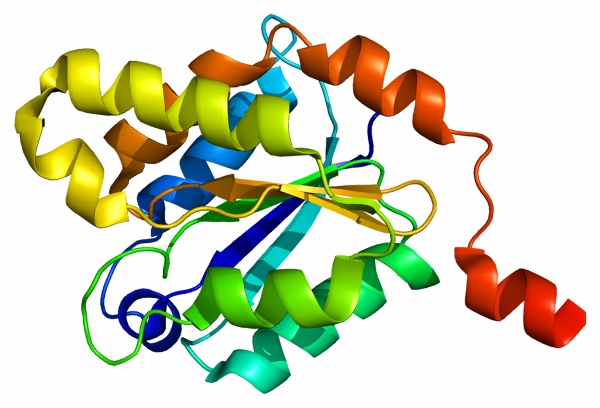Big Data Sheds New Light on the 'Gephyrin Gene'
| Sami Ghanmi | | Mar 30, 2015 11:44 AM EDT |
(Photo : Wikipedia) Structure of the GPHN protein
Using big data analysis, a team of computer scientists stumbled upon new clues that shed light on an important protein called "gephyrin".
The gephyrin protein is a master regulator of receptors in the brain responsible for transmitting messages, according to a report. Its malfunction is attributed to neurological diseases, including schizophrenia, Alzheimer's disease and epilepsy.
Like Us on Facebook
A team from the Washington University in St. Louis' School of Engineering & Applied Science used their own method called BlocBuster to analyze and evaluate massive datasets provided by the International HapMap Project.
With this method, they discovered the gephyrin gene on chromosome 14 broke into two opposites, called yin and yang, thousands of years ago.
"The BlocBuster approach is a paradigm shift from the conventional methods for genome-wide association studies, or popularly known as GWAS, where one or a few markers were examined at a time," said Weixiong Zhang, a professor of computer science and of genetics at the School of Medicine.
"It is truly a data mining technique for big data like those from HapMap and 1000 Genomes projects." Zhang added.
The HapMap project is a public resource of genetic data from populations worldwide. It was established to help researchers study and look for genes related to human disease.
Sherlee Climer, a computer science assistant professor at the university, explains BlocBuster's potential use for observing relationships by comparing it to social media networking.
"For example, you could build a Facebook network using all of your Facebook friends," said Sherlee Climer.
"If two of your friends are friends with each other, you would connect them in the network. If you see that a cluster of people is interconnected with each other, they probably share something in common, such as a family relationship, a school, or some type of social interaction."
The findings show people of African origin generally have more yang haplotypes, which are sequences of markers. Europeans, on the other hand, generally have more yin haplotypes, while Asians nearly possess both yin and yang.
TagsGephyrin Gene, Big Data, Computer Science, International HapMap Project, Protein
©2015 Chinatopix All rights reserved. Do not reproduce without permission
EDITOR'S PICKS
-

Did the Trump administration just announce plans for a trade war with ‘hostile’ China and Russia?
-

US Senate passes Taiwan travel bill slammed by China
-

As Yan Sihong’s family grieves, here are other Chinese students who went missing abroad. Some have never been found
-

Beijing blasts Western critics who ‘smear China’ with the term sharp power
-

China Envoy Seeks to Defuse Tensions With U.S. as a Trade War Brews
-

Singapore's Deputy PM Provides Bitcoin Vote of Confidence Amid China's Blanket Bans
-

China warns investors over risks in overseas virtual currency trading
-

Chinese government most trustworthy: survey
-

Kashima Antlers On Course For Back-To-Back Titles
MOST POPULAR
LATEST NEWS
Zhou Yongkang: China's Former Security Chief Sentenced to Life in Prison

China's former Chief of the Ministry of Public Security, Zhou Yongkang, has been given a life sentence after he was found guilty of abusing his office, bribery and deliberately ... Full Article
TRENDING STORY

China Pork Prices Expected to Stabilize As The Supplies Recover

Elephone P9000 Smartphone is now on Sale on Amazon India

There's a Big Chance Cliffhangers Won't Still Be Resolved When Grey's Anatomy Season 13 Returns

Supreme Court Ruled on Samsung vs Apple Dispute for Patent Infringement

Microsoft Surface Pro 5 Rumors and Release Date: What is the Latest?










